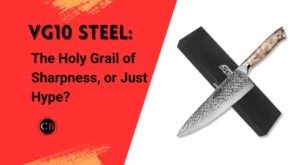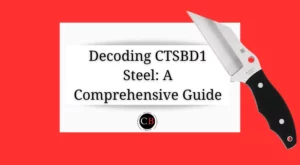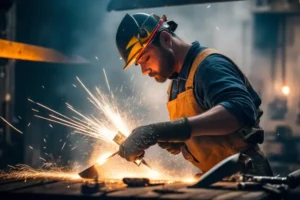Are you on the hunt for a Damascus steel knife but worried about getting scammed by a fake? After all, there are so many replicas available at attractive prices. Therefore, a common question arises how to tell if a knife is real Damascus?
So, my friend, in this article, we have covered the key characteristics of real Damascus steel knives so you can spot a fake from a mile away.
Grab a cup of coffee and dive in!
But before we dive into how to tell if a knife is real Damascus steel, let’s know what Damascus steel actually is.
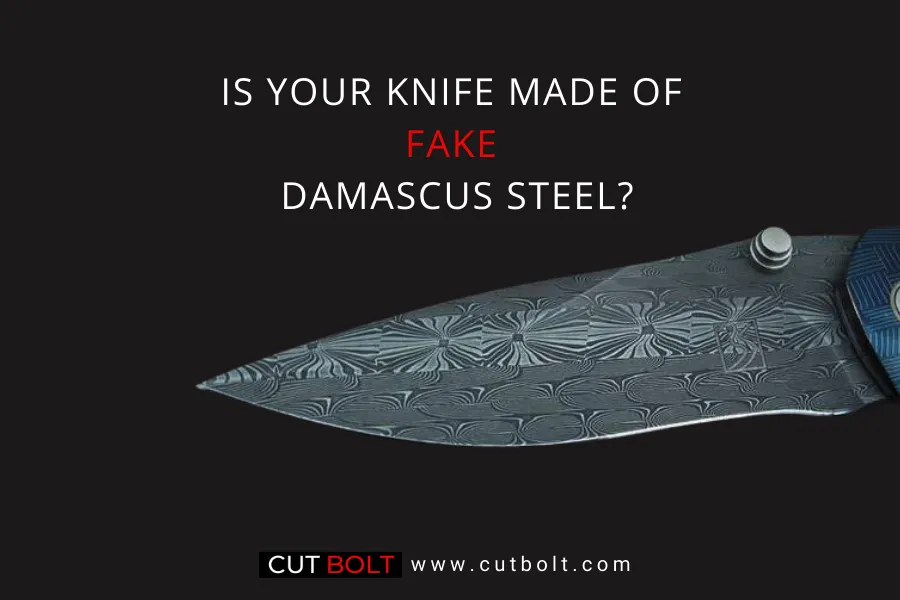
Overview: What are Damascus steel knives?
Damascus steel knives are one of the best multipurpose knives. Ideal for hunting, these knives, specifically those with a fixed blade, are also great for tasks like chopping wood, skinning game, cutting rope, slicing fruit, and much more. These knives come in various forms—fixed blades, swords, Bowie, pocket knives, kukris, etc.
Hand-forged from high-end Damascus steel: each knife is a piece of art. It has sturdy, resilient, and sharp blades featuring a distinctive Damascus pattern incorporated with various premium materials like micarta wood, stag, ram horn, bone, walnut, and many more.
These qualities make Damascus steel knives highly sought after for their quality, versatility, maneuverability, and ornate designs.
What is Damascus steel?
Damascus steel is a distinctive type of high-end, durable, and sharp steel first used to build swords and other weapons.
It is made from two or more different types of steel formed by the process of forging. It is known for its wavy pattern, popularly known as the Damascus pattern. After manufacture, the newly formed steel undergoes repeated folding and forging; to create the wavy pattern.
History of Damascus steel
The origins of Damascus steel can be traced back to the Syrian city of Damascus, in the Middle East, renowned for its skilled blacksmith. It was the city this steel was first used to build swords and other weapons. The high-end strength, durability, and sharpness of the steel made it a popular raw material, rather the first choice for making swords, knives, and other cutting tools.
Properties of Damascus steel
One of the most distinctive features of Damascus steel is the Damascus pattern or wavy pattern. This pattern is created by the layers of steel and iron that are alternately folded and welded together in the forging process.
The final product is not only visually striking but incredibly strong and durable. They have sharp edges and resistance from chipping and breaking.
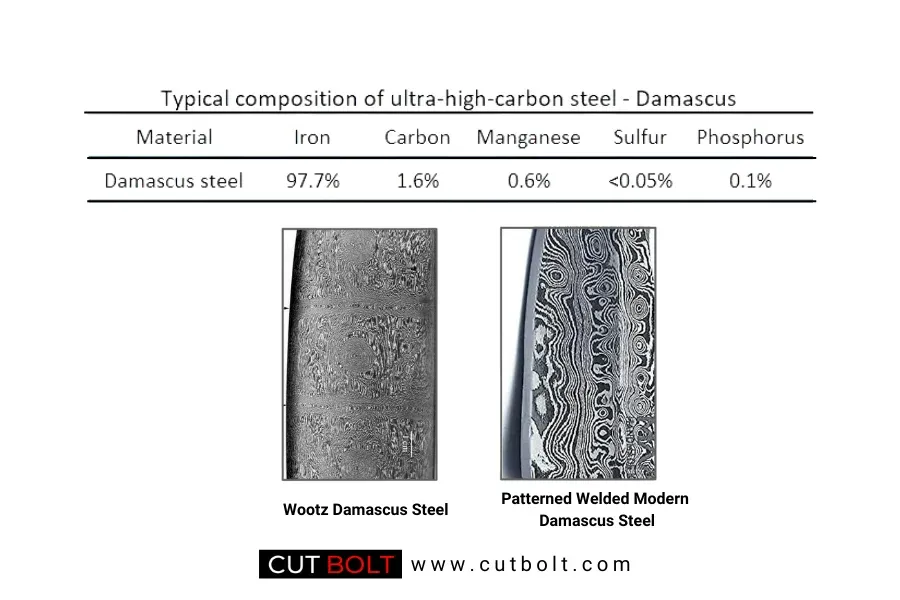
Making Methods of Damascus steel
The production of Damascus steel involves a complex process of forging.
The raw materials are melted in the furnace and poured into ingots that are hammered and folded repeatedly, creating a characteristic layered pattern.
The steel is then heated and quenched in oil or water, which hardens the material and gives its unique properties.
What is Fake Damascus Steel?
Fake Damascus steel is low-quality steel that has been acid-etched or laser-etched to create only the wavy pattern that imitates the look of Damascus steel.
This steel is only a replica of the real Damascus steel. In performance and quality, it has a hell and heaven difference.
Why is Fake Damascus Steel Inferior?
Fake Damascus steel is made by a process, much simpler and cheaper than the traditional forging method. It builds a blade that lacks the properties of original Damascus steel—performance and longevity.
The only resemblance is the characteristic wavy pattern that is acid-etched or laser-etched. Acid makes it prone to rusting, staining, and chipping, as it removes the protective, corrosion-resistant layer.
The laser-etched are though durable lacks the composition of real Damascus steel that gives it its legendary toughness and sharpness.

How to tell if a knife is real Damascus?
Though the price of a Damascus steel knife is a determining factor between the real and the fake, there are many telltale signs to help to recognize whether the knife is a real Damascus steel. Here are the four features.
- Look at the pattern: A real Damascus steel knife has uniform patterns all over the blade—cutting edge, spine, bolster, and tang. Fake Damascus knives may have uneven designs, mostly not folded.
- Check the etching: Real Damascus steel has a clearly visible etching on the blade, easily discernible and uniform. If the etching is not visible, uneven, or looks artificial: the knife may be of fake Damascus steel.
- Location of pattern: The pattern on the real Damascus knife is distributed evenly across the blade, tang, spine, edge, etc. However, on a fake Damascus knife pattern may run only across the blade’s surface.
- Accuracy of the designs: Real Damascus knives have well-defined patterns precisely represented, whereas the replica knives don’t follow the same level of accuracy.
- Texture: The texture reveals a lot about the originality of the Damascus knife. The imitated knife has an evenly smooth surface. But the real Damascus knife will have a slightly grainy texture.
How to avoid buying a fake Damascus steel knife?
The best way to avoid buying a fake Damascus steel blade is to know what to look for. Here are 5 tips you should consider while choosing a Damascus steel knife:
- Check the price: If the price; seems too good to be true, it is likely a fake Damascus knife. Authentic Damascus steel knife is expensive as it is the product of skilled craftsmanship. If a knife claiming to be of Damascus steel is available at a bargain price, it is likely an imitation.
- Inspect the pattern: Real Damascus steel has distinct visible patterns made by repeated forging that runs through the entire blade. Fake Damascus steel patterns, however, often look artificial and repetitive, with no depth or variation.
- Test the edge: Real Damascus steel is renowned for its sharp chip-resistant edges. If a blade claimed as Damascus steel does not hold a sharp edge or easily chips or dulls, it is likely a replica.
- Research the brand: Look for reputable brands having a history of making high-quality knives with Damascus steel. Avoid buying from unknown or shady brands offering no warranty or customer support.
- Get a Professional Opinion: If you are still unsure whether a knife is real or fake, it is always good to gain an expert opinion. Visit a reputable knife shop or expert and have them inspect it.
How to Craft Damascus steel Knives?
The making of Damascus steel knives involves different methods, which give it the characteristic pattern and quality. But how is the steel manufactured? It is done with two processes—forging Wootz steel and pattern welding.
1. Forging Wootz Steel
Forging Wootz Steel involves iron and steel smelting, with other materials like sand and glass, with wooden chips. Wooden chips are mandatory, as they become carbon which the melted iron absorb, resulting in the 1% carbon content. Repeated forging, pressure, heat, and controlled cooling limit the carbon content to 1%; however, impurities remain within the blades.
The repeated forging process and controlled cooling create longer precipitate layers that form the iconic wavy pattern, subtle and less prominent. Acid etching and polishing make the wavy pattern more visible: resulting in an authentic Damascus knife.
It is the primitive process of making Damascus knives. Hence, Damascus steel knives made by forging Wootz steel are authentic Damascus steel.
Remember: Highest quality Damascus steel contains one to two percent carbon. Generally, the best version of Damascus steel contains around 1.5 percent carbon. The modern pattern welded Damascus steel contains one to less than one percent of carbon. That is not the highest quality, but enough for most applications.
2. Pattern Welding
Pattern Welding is a modern method of preparing Damascus steel. It involves multiple layering of iron and steel sheets and repeated forging under excessive heat treatment. To be precise, two layers of sheets are merged, heated, and beaten until they meld together to form a bar or billet. The bar is then folded, heated, and hammered until several layers form.
The resulting welded pattern contains about 40 to 67 layers. For the prominent Damascus pattern, the steel is finished with acid etching and polishing.
Pattern-welded Damascus steel blades have homogenous layers containing less than 1% carbon and fewer impurities. Hence, they are superior to their primitive Wootz steel counterparts. This technique is the method used today to create Damascus steel knives.
Remember: In order to achieve a Master Smith rating from the American Bladesmith Society, which was founded by Moran, the smith is required to craft a Damascus blade using at least 300 layers.
3. Exclusive Acid Etching
To enhance the Damascus folds and make the wavy pattern more prominent in the wootz steel-forged and pattern welded knives: real Damascus steel designer acid-etch it.
However, some manufacturers fake the wavy pattern welded Damascus blades acid etch, or laser etch carbon steel or stainless steel blades. But, they lack the inherent qualities of a Damascus steel blade. They only aesthetically mimic the Damascus pattern.
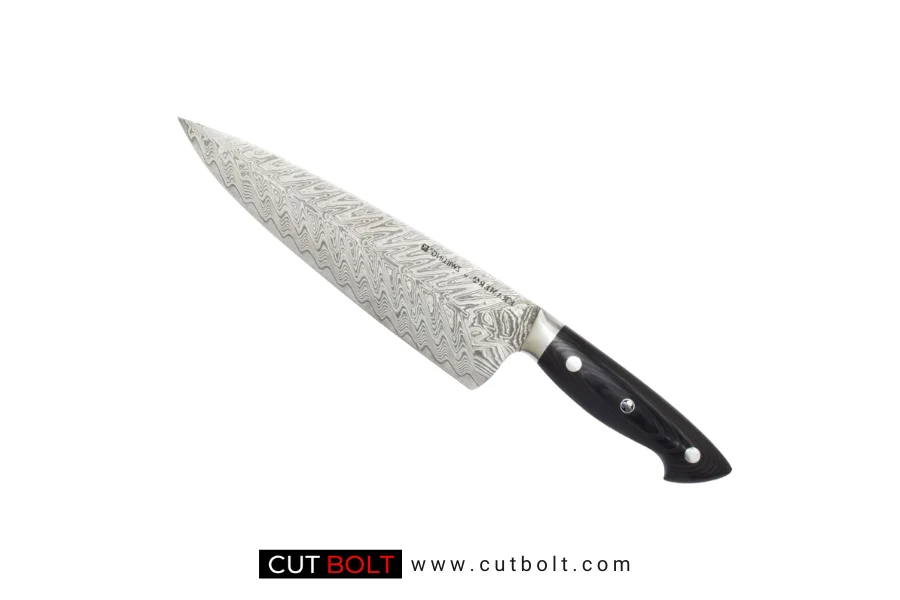
FAQs: How to tell if Damascus steel is real
Is Damascus steel worth the investment?
Absolutely Yes! Damascus steel knives are known for their durability and strength, making them a worthy investment for anyone who loves cooking or collecting knives.
Can I sharpen a Damascus steel knife myself?
Yes, sharpening a Damascus steel knife is possible by oneself. We recommend taking it to a professional to ensure you don’t damage the blade.
Are there any downsides to Damascus steel knives?
The only real downside to Damascus steel knives is their price. They can be expensive. But if you’re looking for a high-quality knife: it is a lifetime investment. Hence, it is worth the investment.
Can I use a Damascus steel knife for everyday cooking?
Absolutely Yes! Damascus steel knives are great for everyday use in the kitchen, from chopping vegetables to carving meat.
How do I care for my Damascus steel knife?
To care for your Damascus steel knife, we recommend cleaning it with warm, soapy water and drying it thoroughly after each use. Also, oil the blade occasionally to keep it in top condition.
Final Word: How to tell if a knife is real Damascus steel?
There are several key characteristics that set real Damascus steel knives apart from fakes. By checking the price, pattern, welds, weight, edges, handle, sheath, and brand, you can ensure you’re getting a high-quality knife.
And let’s be real, you don’t want to be caught dead with a fake Damascus steel knife. Not only will your fellow knife enthusiasts judge you, but your fake knife might not even be able to cut through a stick of butter. So, it’s worth taking the time to do your research and make sure you’re getting the real deal.
But let’s be honest, sometimes it’s hard to resist the allure of a cheap knife. I mean, who doesn’t love a good bargain? But when it comes to knives, you really do get what you pay for. And if you’re looking for a high-quality, durable knife that will last a lifetime, it’s worth investing in a real Damascus steel knife.
And don’t worry, you don’t have to be a knife expert to spot a fake. Just follow the tips we’ve outlined here, and you’ll be well on your way to becoming a Damascus steel knife pro.

